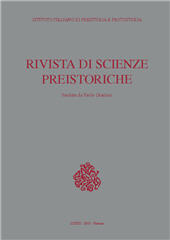Nuclei familiari e popolazione di villaggio nel mondo terramaricolo : un approccio demografico basato sul rapporto tra persone e spazi domestici
P. 1-29
This paper aims to analyse how the households and the settlement populations developed in the Terramare area between the Middle Bronze Age 2 and the Recent Bronze Age (1550-1150 BC). More specifically, using settlements and ethnographic data with a quantitative approach, it has been analysed what the traits of the Terramare households were and how they developed over time. Secondly, the analysis moved the focus from the family to the whole village population to understand how much the demographic density could change in relation to the size of the settlement and to other factors. Research on the development of households and village populations requires a quantitative method to estimate how many people constituted a family unit and an entire village community: meaning, therefore, a procedure for the calculation of people.
The quantitative methods used here are based on the relationship between the floor area and number of people. In other words, the methods based on the fixed relationships between the size of the houses and the number of people living in them. Through this demographic approach, it has been highlighted that, from the Recent Bronze Age or from the final phases of the Middle Bronze Age, larger families coexisted with the nuclear ones. It has been supposed that these larger households could correspond to small extended families, maybe comparable to the “stem family” model. As regards the calculation of settlement population, it has been noticed that there is an allometric ratio between population and settlement size: in villages less than 1 hectare the population density decreases as the size of the inhabited area increases, whilst in those above 1 hectare the population density is constant. [Publisher's text]
-
Articles from the same issue (available individually)
-
Information
DOI: 10.32097/1216
ISSN: 2282-457X
KEYWORDS
- Età del Bronzo, Terramare, Demografia, Nucleo familiare
- Bronze Age, Terramare, Demography, Household


